metal ceramic restorations
1/166
There's no tags or description
Looks like no tags are added yet.
Name | Mastery | Learn | Test | Matching | Spaced |
|---|
No study sessions yet.
167 Terms
the metal-ceramic restoration consists of a ______ substructure supporting a ______ veneer that is _________ and _______ bonded to it
a metal substructure supporting a ceramic veneer that is mechanically and chemically bonded to it
how is does the chemical componentof the bond achieved
through firing
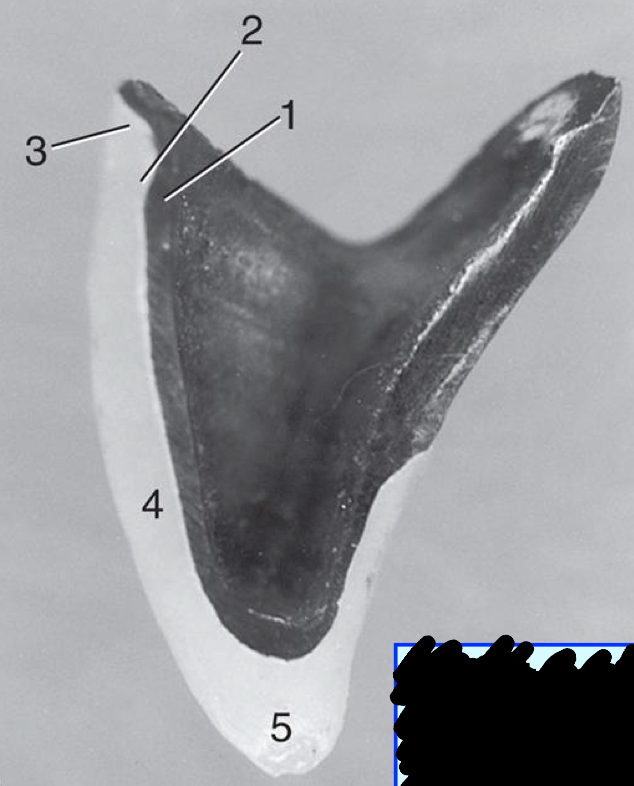
1
metal substructure

2
opaque porcelain

3
gingival porcelain
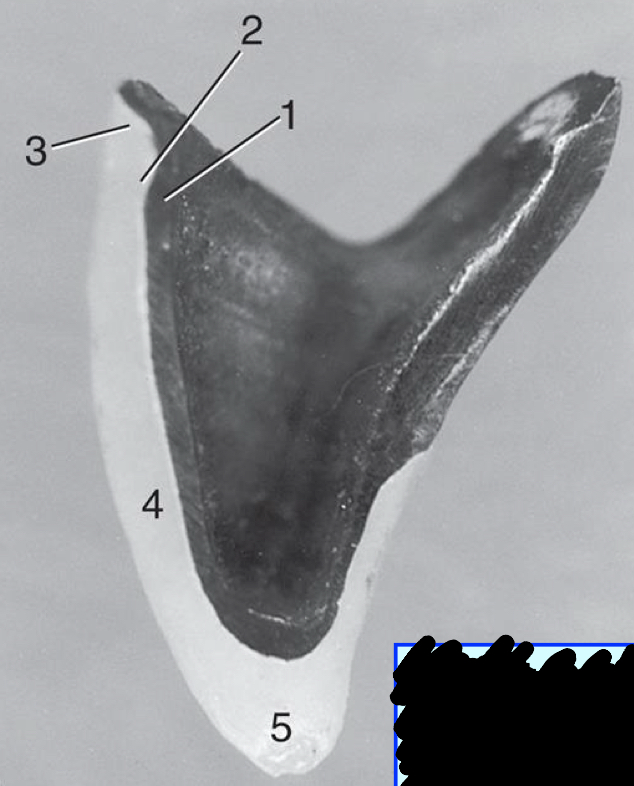
4
body porcelain
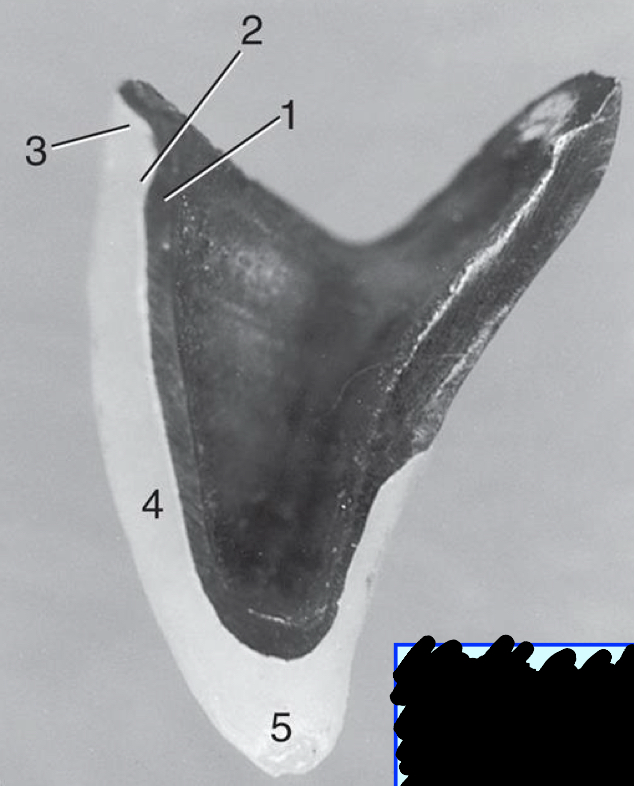
5
incisal porcelain
what are the types of metal ceramic restorations
metal ceramic crowns
porcelain fused to metal (PFM) crowns
ceramic-veneered crowns
indications for metal ceramic restorations (5)
similar for complete cast crowns:
extensive coronal destruction
maximum retention and resistance form
correction of axial wall
restore endodontically tx tooth
esthetic demands
are all-ceramic restorations or metal ceramic restorations more esthetic
all ceramic restorations
contraindications for metal ceramic restoration
pt has active caries or untx periodontal disease
young pts w large pulp chamber
when more conservative restoration is feasible
advantages of metal ceramic restorations (3)
strength of complete cast restoration w esthetics of all ceramic crown
is the better choice to serve as a retainer for fixed partial denture (FPD)
can be used for survey crowns
why are metal ceramic restorations better used to serve as a retainer for a FPD
its metal substrate can accommodate cast or soldered connectors
why can metal ceramic crowns be used for survey crowns
modified to incorporate occlusal and cingulum rests and milled proximal and reciprocal guide planes in their metal structure
disadvantages of metal ceramic restoration (6)
requires significant tooth reduction
in highly esthetic areas, margin needs to be placed subgingivally → inc potential for periodontal disease
have slightly inferior esthetic compared to ceramic restoration
fx of ceramic layer when it is not designed or processed properly
difficult shade selection
more expensive laboratory costs
what are the 4 classifications of metal alloys for metal ceramic restorations
high noble alloys
titanium alloys
noble alloys
predominantly base alloys
examples of noble metal content
gold, platinum group metal
requirement for high noble alloys
noble metal content >/= 60% and gold >/= 40%
requirement for titanium and titanium alloys
titanium >/= 85%
requirement for noble alloys
noble metal content >/= 25%
requirement for predominatly base alloys
noble metal content < 25%
is silver a noble metal alloy
NO
high noble/noble-metal alloys have good ________ resistance
corrosion resistance
what high noble/noble-metal alloys have desirable yellow color
Au-Pt-Pd
what high noble/noble-metal alloys are added to for oxide layers to produce a desirable ceramic-metal bond
indium (In), Tin (Sn), and Iron (Fe)
what base-metal alloys provides tarnish and corrosion resistance
chromium
what base-metal alloys are added to dec the thermal coefficient of expansion
molybdenum
what base-metal alloy becomes important for metal ceramic restorations in the future/oxide layer
Ti alloys
what is the importance of the oxide layer
for when you want a bond between cermic and metal
do base-metal alloys or noble/high-noble alloys have a superior mechanical property (elastic moduli and hardness are high)
base metal alloys
base metal alloys can also be _____ for resin bonding
etched
negative characteristics of base metal alloys (6)
markedly higher corrosion in acidic environments
difficult finishing and polishing
dark, thick oxides
risk of pt allergy
difficult soldering
harder to cast and ensure appropriate marginal fit of restoration
why are base metal alloys harder to cast and ensure appropriate marginal fit of restoration
their liquidus temperatures are the highest among all prosthodontics alloys
what are the 3 types of dental ceramic (porcelain)
quartz (Silica-SiO2)
feldspar
kaolin/other oxides
what is feldspar ceramic
potassium aluminum silicate orthoclase and sodium aluminum silicate
rank silica, kaolin, and feldspar from msot to least common dental ceramics
feldspar > silica > kaolin

classifications of dental ceramic
high fusing porcelain
medium fusing
low fusing
ultralow fusing
what is the fusion temperature
temp at which the powder particles of dental ceramic fuse together
applications for high fusing porcelain
denture teeth and fully sintered alumina and zirconia core ceramics
sintering temperature range for high fusing porcelain
> 1300 C
applications for medium fusing porcelain
denture teeth, presintered zirconia
sintering temperature range for medium fusing porcelain
1101-1300 C
applications for low fusing porcelain
crown and bridge veneer ceramic
sintering temperature range for low fusing porcelain
850-1100 C
applications for ultralow fusing porcelain
crown and birdge veneer ceramic
sintering temperature range for ultralow fusing porcelain
< 850 C
porcelain is _____ (strong/weak) under compression but ______ (strong/weak) when placed under tension
porcelain is strong under compression but weak when placed under tension
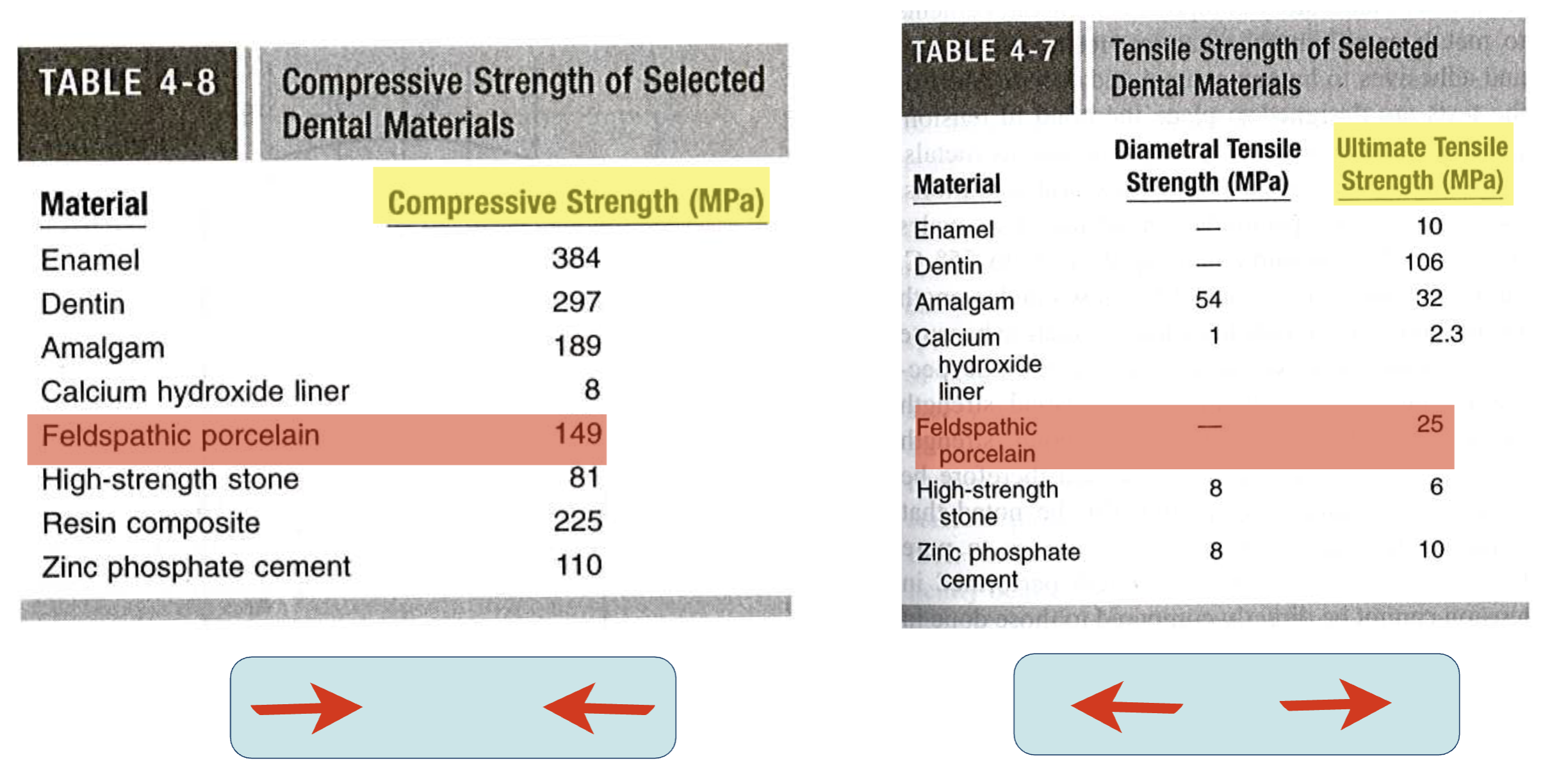
what is the coefficient thermal expansion
the change in length per unit length of a material for a 1 degree C change in temperature
the coefficient thermal expansion of the metal alloy needs to be slightly ______ (higher/lower) than the dental cermic
metal needs to be slighly higher than ceramic
what factors can affect the bond between the ceramic and metal
the oxide layer between the metal and cermic
airborne-particle abrasion w aluminum oxide (alumina) on alloy castings to provide mechanical interlocking
the linear coefficients of thermal expansion for th emetal and ceramic must closely match to achieve a strong bond interfacial bond
what technique is commonly used in the fabrication of porcelain
lost wax technique
what are the layers of procelain during fabrication
opaque layer
body porcelain
enamel porcelain
surface glaze
what is waxing to anatomic contour
full anatomic contour and then cutting back for a consistant amount of porcelain
having even porcelain thickness will provide superior ______ properties in the completed restoration and standardizing ______ reproduction
superior mechanical properties; standardizing shade reproduction
shape of metal preparation
avoid sharp angles on the veneering surface
convex surfaces and rounded contours
smooth surface
why should you avoid sharp angles on the veneering surface of the metal preparation
bc they can contribute to internal stress in the fired porcelain
purpose of smooth surface in the shape of metal preparation
facilitates wetting of the framework by the porcelain slurry
the intended metal-ceramic junx should be as ______ and as ______ as possible
should be as definite (90 degree angle) and as smooth as possible
metal framework thickness requirements for noble metal alloys vs base metal alloys
noble metal alloys: 0.3 mm
base metal alloys: 0.2 mm
the metal-ceramic interface must be far away from all centric occlusal contacts and must be distinct, it needs to be at least ___ mm away
1.5 mm
after investment removal, how should it be cleaned
ultrasonic
airborne particle abrasion
steam
during metal preparation, the oxide layer has been formed on the metal surface duing ____ must be partially removed w ____ or _____ abrasion
during casting; removed w acid or air abrasion
achieving a successful bond depends on a controlled thickness of the…
metal-oxide layer
how should you do metal finishing
one direction without dragging the metal over itself- entrapping air and grinding debris
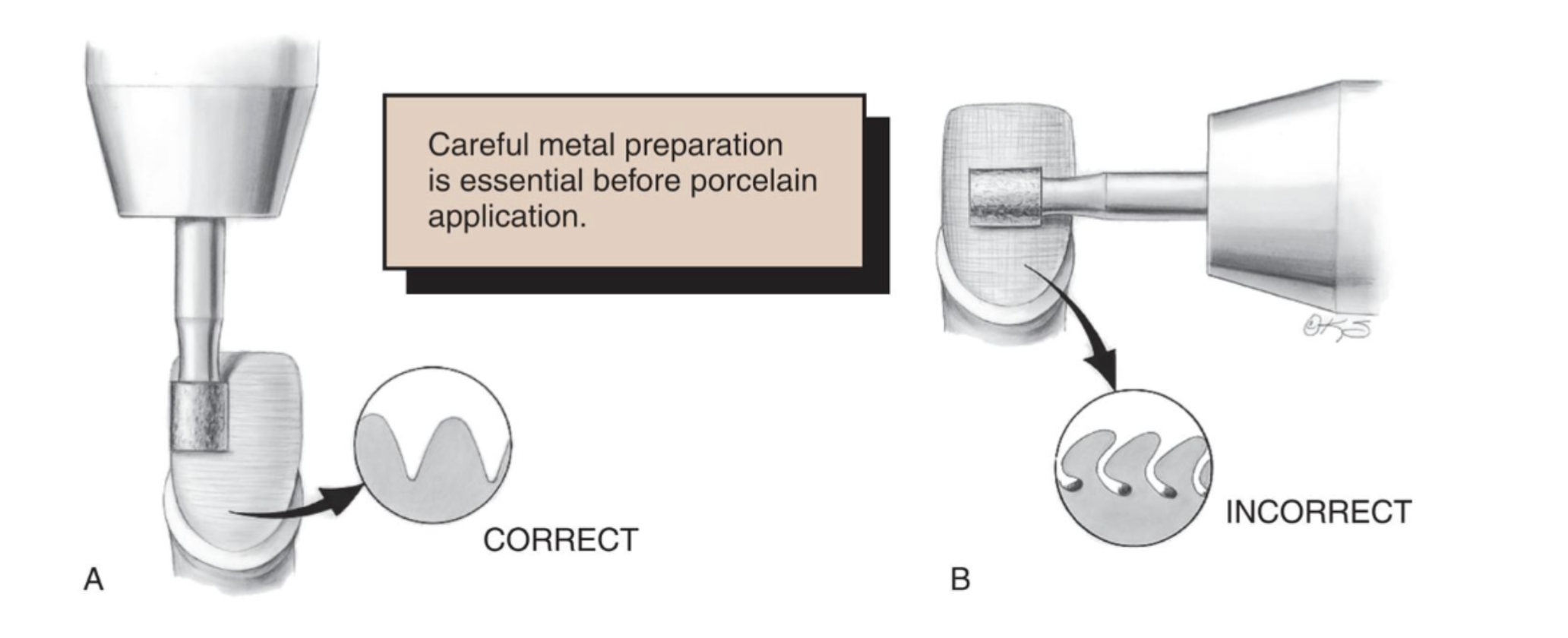
in metal preparation, what do you want to finish w
ceramic-bound stones or tungsten carbide burs
after the metal surface has been smoothed, what should you do
should be airborne-particle abraded w aluminum oxide according to the manufacturer instructions
what is necessary to verify that the metal substructure conforms to all specified minimum dimensions
dial or metric caliper
in metal preparation, less than ____ mm may lead to distortion during firing
0.3
steps of finishing in metal preparation
(A) nonveneering surface: rubber wheel stage
(B) (C) metal ceramic junction: tungsten carbide bur
(D) veneering surface: ceramic bound stone
(E) airborne-particle abrasion of the veneering area
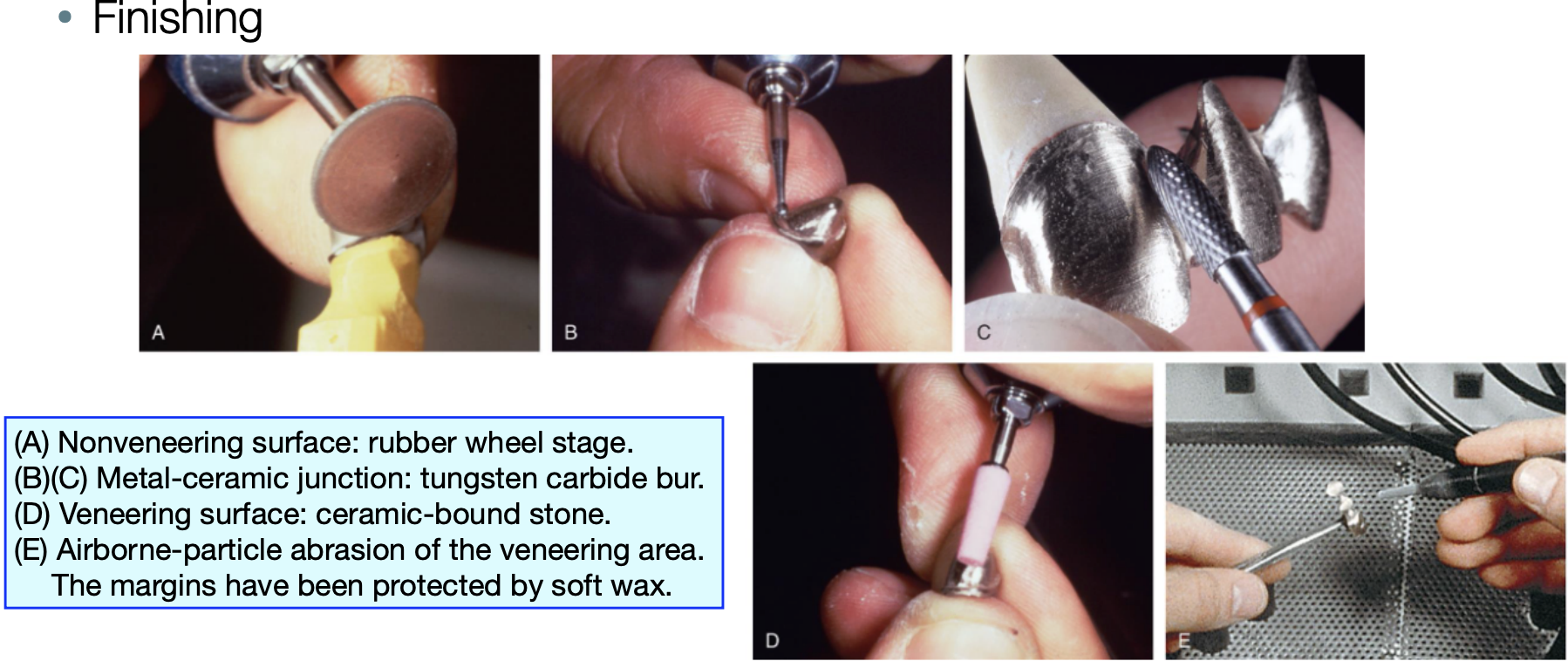
how to protect the margins during finishing
soft wax
how to clean metal in metal preparation
immersion in a general-purpose cleaning solution in an ultrasonic unit for 5 minutes
steam clean
a controlled oxide layer must be created on the metal surface to establish…
chemical bond between metal and porcelain
how to create the oxide layer
insert substructure into a porcelain furnace above the porcelain firing temp w or w/o vacuum
to create an oxide layer, which requires a longer holding time
high noble alloy
noble
base metal
high noble alloy
to create an oxide layer, which requires a less holding time
high noble alloy
noble
base metal
noble
to create an oxide layer, which has no required oxidizing cycle
high noble alloy
noble
base metal
base metal
purpose of opaque porcelain
bonds to alloy
masks the color of the alloy
________ (body/enamel) of dental porcelain powders provides the most shade to match natural teeth and bonds to the opaque porcelain
body
________ (body/enamel) of dental porcelain powders is the most translucent
enamel
condensation techniques is by ______ action in the dental porcelain technique
capillary
how to do the condensation technique
gentle patting w a brush and light tapping on the cast produces adequate vibration during the preliminary stage of condensation; a tissue is held close for removal of excess surface moisture
what is sintering
when the mass is heated, individual porcelain particles conglomerate and bridge together

during sintering, a loss of interstitial space occurs, accompanied by as much as a ___% to ____% volumetric shrinkage after firing
27%-45%
outcome of bisque bake
not as shiny as tooth
to create a shiny surface similar to the natural teeth, a bisque baked ceramic needs to be _____
glazed
what happens to porcelain after being glazed
the surface porcelain is vitrified a glossy and smooth surface is created
what is autoglazing
oven temp is raised to the fusion temp and the bisque baked is maintained in that temp before cooling, occlusal contacts are altered during glazing
what is overglazing
a seperate mix of powder and liquid is applied to the surface and the restoration is fired
to create a natural looking tooth, ___________ may be incorporated
colored pigments
how to add internal characterization
pigments can be incorporated in the opaque, body, or incisal powder
when is external characterization done
is preformed during overglazing
what is external characterization
pigments are added to the surface of the bisque baked porcelain then they are fired in glazing temp
steps for metal-ceramic restoration as the same as
complete cast crown
what can cause fx during bisque bake (4)
improper condensation
improper moisture control
poor framework design
incompatible metal-porcelain combination
what can cause bubbles in metal-ceramic restorations (5)
too many firings
air entrapment during buildup of restoration
improper moisture control
poor metal preparation
poor casting technique
what can cause unsatisfactory appearance in metal-ceramic restorations (4)
poor communication w technician
inadequate tooth reduction
excessive thickness of opaque porcelain
excessive firing
what can cause clinical fx in metal-ceramic restorations (3)
poor framework design
centric stops too close to metal-ceramic interface
improper metal preparation
christensen’s survery estimated the longevity of crowns to be from…
21 to 22 years
survey by Maryniuk and Kaplan survey for longevity of metal-ceramic crowns were
12.7 years
in review of records in 40 Dutch dental offices, leempoel et al told of 10-year survival rates in _____% for full crown and ___% for metal ceramic crowns
98% full crowns; 95.3% for metal ceramic crowns